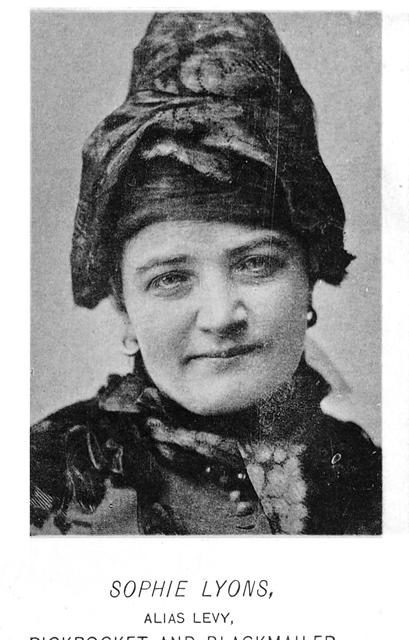We have in jail again one of whom perhaps a few here and in Detroit and Jackson have heard. Her name is Sophie Lyons, and she has been returned from the Work house for a new trial. She has already cost the county a large sum of money in the two trials she has had and the case may be taken to another court or perhaps not again prosecuted here. However it is to be hoped that no pains or money will be spared in giving this noted outlaw her just deserts. It would not be a bad reputation for Washtenaw County that it was a hard one for criminals.
–Ann Arbor Courier, July 13, 1883
—
She’s been forgotten now, but for years the name Sophie Lyons raised the hackles of policemen throughout the world. She was particularly unpopular in southeastern Michigan. She had an interesting history in Ann Arbor, where she was tried three times for pickpocketing a watch and chain at the Washtenaw County Fair in 1881.
The fair, held in October on former farmland in what is now the north Burns Park neighborhood, gave farmers a place to display their harvest bounty and compete for cash prizes. “There were ninety entries of poultry, about sixty of sheep, 165 of fruit and sixty-five of grain and seeds,” the Detroit Free Press reported. Oxen, swine, horses, “fat cattle” and steer were also on display, along with flowers, butter, cheeses, and sweetmeats. There was a hot air “balloon ascension,” and purses of between $40 and $150 were offered in a variety of horse races. There was even a competition for the prettiest baby. (The infant of Mrs. George Moore of Fourth Ave. won.)
The atmosphere was festive despite the cold, rainy weather that dogged the fair during its first two days. On the third day the weather improved, and the crowds swelled. Harriet Cornwell, the elderly wife of a wealthy Ypsilanti paper mill owner, attended the fair that Thursday.
Cornwell was in the Floral Hall when a lady wearing a broad-brimmed hat with a veil stopped and asked her if she’d dropped her handkerchief. Cornwell wasn’t sure, but after checking she discovered that she had. The woman offered to find it for her. Cornwell wasn’t in good health, and she gladly accepted the kind offer. The woman asked bystanders to move back so she could find the hanky. After she located it and handed it to Cornwell, she left so quickly she seemed to have vanished into thin air. Cornwell didn’t even get a chance to thank the veiled stranger for her kindness.
It wasn’t until after she got back home that Cornwell noticed her gold watch and chain were missing. She thought the watch and chain might have been stolen at the fair, so she reported it to the police. She didn’t associate the loss with the woman who’d retrieved her handkerchief.
—
Meanwhile, superintendent Andrew Rogers of the Detroit police was busy seizing packages mailed to the home of Sophie Lyons at Fort and Twenty-third streets. Lyons had been a thorn in Rogers’ side since 1877, when she was jailed for shoplifting.
Born Sophie Elkin on Christmas Eve 1847, she was taught to pickpocket and shoplift as a child by her parents, who were part of New York City’s criminal underworld. By the age of twelve she was in prison for burglary at the New York House of Refuge on Randall’s Island. After her release from that institution she worked for Fredericka “Marm” Mandelbaum, an infamous fence. By the age of eighteen she was married to her second husband, Ned Lyons. Like all four of her “official” husbands, Lyons was also a criminal.
Lyons moved to Detroit in the late 1870s, partly because of its proximity to Canada–she was able to flee there when things got unpleasant for her at home. Despite the best efforts of the police, Lyons, who had an escape from Sing Sing Prison under her belt, managed to engage in persistent criminal activity in Michigan.
In 1881, she attempted to blackmail George Hendrie, the owner of the Detroit City Railway. Claiming Hendrie had been her lover and had fathered a child with her, she demanded “reparations” and threatened to go public if he didn’t pay. Hendrie stubbornly refused. Lyons then tried to shoot Hendrie at his Detroit office. Fortunately she was a bad shot, and the bullet missed its target. She was charged with “shooting with intent to kill.”
Lyons had also accused several other wealthy Michigan men of the same thing and tried to blackmail them too, but Hendrie was the only one she’d tried to shoot. After her trial for the shooting was over, her lawyers successfully requested that the results be suppressed, but since she didn’t go to prison, she must not have been convicted. Lyons always hired the best attorneys and had the money to pay them well.
Rogers suspected that Lyons was also pickpocketing and shoplifting on his turf. But she was so clever that it was difficult to find any evidence against her, so he resorted to an unusual tactic. He hired a poor Detroit widow, Theresa Lewis, who was desperate for cash, to ingratiate herself with Lyons in order to gather evidence against her. Lewis became a confidential informant for Rogers.
In the summer of 1881, Lewis went to Lyons’ house and asked to read the Bible with her. Sophie wanted nothing to do with the Bible, but she offered to let Lewis stay as a tenant.
Lewis moved in and began to spy on Lyons and report back to Rogers. She told Rogers that Lyons’ housekeeper, Sarah Brew, received many packages containing stolen goods, sent to her from out of town by a “Sarah Smith” who was really Lyons. Lewis kept some of the wrappings from the packages and gave them to the police.
Rogers then instructed one of his officers to intercept packages addressed to Brew at the post office. The officer seized packages sent from Cleveland that contained watches and jewelry. Lyons had told friends that she’d been in Cleveland in September to attend President Garfield’s funeral.
Another intercepted package was mailed from Ann Arbor. It contained Harriet Cornwell’s gold watch and chain.
—
Lyons was charged with “larceny from the person” for the theft of Cornwell’s valuables. She was placed on trial at the Washtenaw County courthouse.
In order to get a conviction, prosecutors had to prove Lyons was at the fair in Ann Arbor on the day the watch and chain were stolen. This was difficult, because she wore a hat and veil wherever she went, including in the courtroom during her trials. Some witnesses were certain they had seen her in Ann Arbor. Others weren’t so sure. Her attorney found several witnesses who knew her, and they testified with confidence that she’d been in Detroit the day the watch was stolen.
According to the prosecutor, when the judge ordered Lyons to show her face to a witness, she “sprang like a panther, tore her wrappings from her head and face and rushed to the witness, thrusting her face close up” to the witness’s face. She kept her back to the courtroom and immediately replaced the hat and veil after the witness got a look at her.
Lyons was volatile in court–at times she cried, asking who would care for her five children if she went to prison. Other times she threatened violence against prosecution witnesses. She had a sharp tongue and seemed to enjoy using it.
Lyons’s trial attracted large crowds. Many attended hoping to hear her fling insults at Lewis, who had also been a witness against her at an earlier trial in Detroit. In that trial, Lyons had accused Lewis of stealing things from her home–so persuasively that Lewis herself was charged with theft. (She was acquitted.)
In court in Ann Arbor, Lyons and Lewis even physically fought. At one point the judge ordered the two women to stand next to each other in order to compare their height. Lyons took the opportunity to bash into Lewis, sending her flying across the courtroom.
The prosecution prevailed, and in March 1882 Lyons was convicted of stealing Cornwell’s watch and chain. She was sent to the Detroit House of Correction–only to be released seven months later, when the Michigan Supreme Court reversed her conviction. She was tried again in Ann Arbor and convicted a second time in February 1883. She was sent to “DeHoCo” again–only to be released again when the Supreme Court overturned her second conviction that July.
Her money exhausted and her health poor after two incarcerations, Lyons begged the judge to drop the charges, but he refused. Her final trial in Ann Arbor was held in March 1884. This time, she was found not guilty.
Lyons had finally and definitively escaped conviction for the theft of Cornwell’s valuables. However, her legal troubles weren’t over yet.
—
She was immediately returned to Detroit, where she was held on charges related to pickpocketing in Cleveland. Lewis was also an important witness in that case–but by then, she was suffering from cancer.
Lyons’s lawyers got so many postponements that she still hadn’t gone on trial when Lewis died in May 1886. The charges were then dropped. Lyons left Detroit and headed to other cities where she was less well known.
That same year, Thomas Byrnes, the chief of detectives at the New York City Police Department, published Professional Criminals of America. In it, Byrnes described the 204 criminals he considered to be the most dangerous individuals in America.
Lyons was one of only eighteen women to make the cut. Byrnes noted in her bio that she had been recently “convicted at Ann Harbor, Michigan,” but his information was already out of date.
According to the Free Press and other newspapers, Lyons spent the next fifteen years shoplifting, pickpocketing, robbing banks, and blackmailing people all over the Midwest and East Coast and in Europe, but ultimately she returned to her home in Detroit. By the early twentieth century Lyons claimed she’d reformed and even published a memoir, titled Why Crime Does Not Pay. Though she had given up crime, her by-then substantial fortune came partly from her earlier criminal activities. The irony of her book’s title was presumably deliberate.
If Lyons ever made another visit to Ann Arbor after 1884, she kept it quiet. No doubt she wanted to avoid the town where she was put on trial three times for the same crime–it was a record for her, and not one she would have bragged about. She died in 1924 at Grace Hospital after collapsing of a stroke in her home. Her cremated remains were buried next to those of her favorite child, Carleton Mason, at Detroit’s Woodmere Cemetery.




